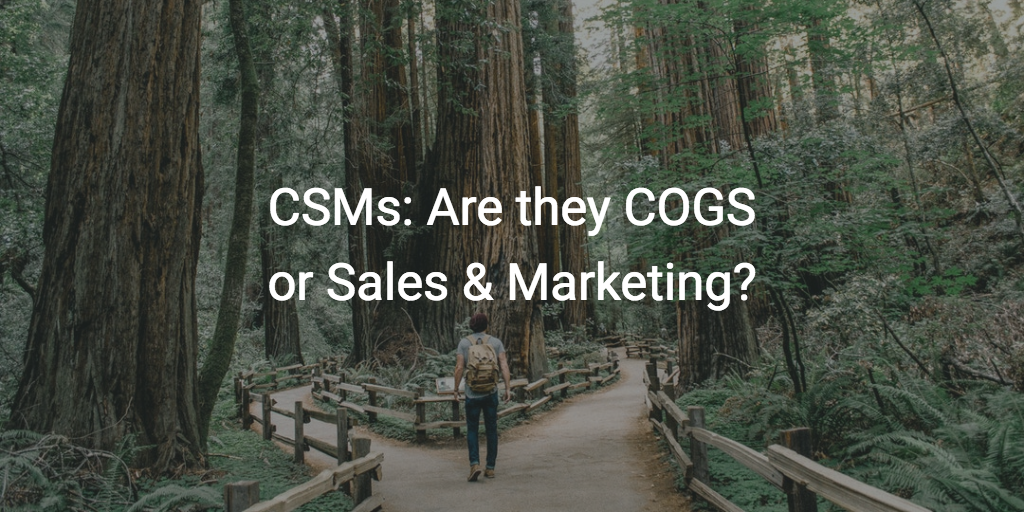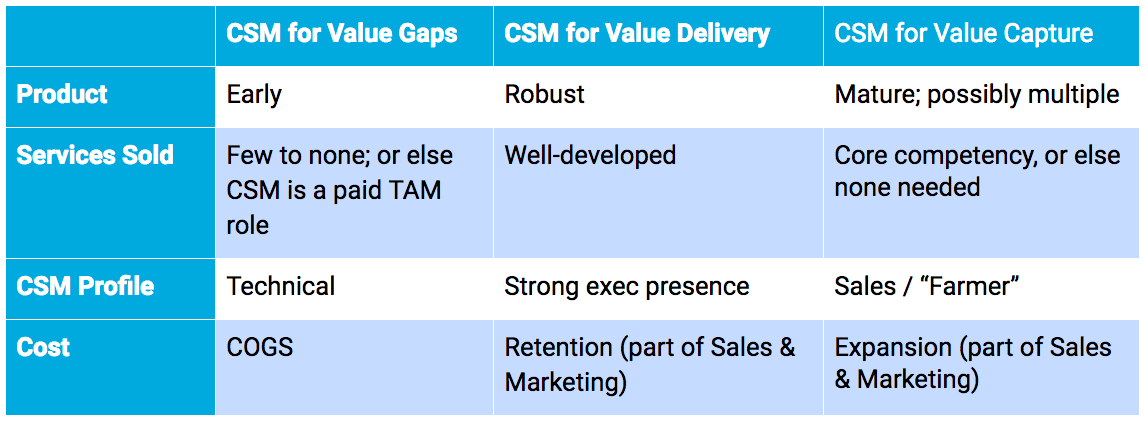I hear these two questions in the Customer Success community all the time:
- What profile of Customer Success Manager (CSM) should I hire?
- Does CSM count as Cost of Goods Sold (COGS) or Sales & Marketing?
These two questions are fundamentally related. The key to answering them is figuring out which of three categories you fall into:
1. “CSM for Value Gaps”
Because it’s early days, your product doesn’t deliver enough value out of the box, so your CSM fills the gaps. They’re highly technical and create (sometimes ingenious) hacks to solve problems. Theoretically, this type of CSM could be charged for as a service, but your clients aren’t willing to pay (so you need to invest the work as free), or else you haven’t had the time or expertise to develop a services program yet. Over time, you may figure out how to package up this role as a paid recurring Technical Account Management (TAM) service. You categorize your CSM expense as COGS because the CSM is essential to delivering the product that the client purchased.
As your CSM creates hacks, your clients may accumulate tech debt. Your board is unhappy that you are asking for so much headcount (especially because it detracts from your Gross Margin) and tell you that you should find a scalable solution through the product (more on that here). But your clients are getting value and renew at an acceptable rate.
2. “CSM for Value Delivery”
Your product has evolved. The gaps are no longer large, and you’ve figured out how to plug the remaining ones by selling services to offset the cost of extra work that your team needs to do (and you specialize that work into a Services team). You realize that delivering value isn’t just about getting feature adoption; it’s also about managing client teams through the changes in behavior that the software prescribes. To achieve this, the CSM must build trust, reconcile different points of view in meetings at the client, communicate persuasively, mobilize the group behind a plan, and gain the respect of executives, who are often the decision-makers for renewing the product. You hire CSMs for their interpersonal skills. You focus them on a certain “lifecycle” of activities: kickoffs, milestone meetings, executive business reviews, and renewal conversations.
Your retention rates improve and your Sales team is happy because they can focus less of their time on escalations and more on hunting and expanding existing accounts. The CSMs count toward Cost of Retention (part of Sales & Marketing) since they contribute to the renewal, even if they don’t have formal quota responsibility.
3. “CSM for Value Capture”
You have a strong methodology for delivering value to clients through your product (which may be very simple or intuitive) and/or through services (which are essential if the product is complex). Your CSMs are focused on monetizing the value that you’re delivering (by upgrading clients to a new tier), selling into white space, by pitching new use cases, finding new teams to sell to, or selling new products. The CSMs’ skills lie in exploiting opportunities: overages, white space, and organizational dynamics or politics. You hire CSMs who enjoy building long-term relationships and getting deals done. They have a quota and may have the title Account Manager. They count toward Cost of Expansion.
One of these three models isn’t necessarily better than the others; your choice depends on your situation. Choose wisely!
I encourage you to listen to a webinar I recorded alongside our CFO and CIO in which we answered listener questions about budgeting for Customer Success in 2019. It contains a lot of helpful ways to think about your CSM strategy and spend. Click here to watch the webinar.


